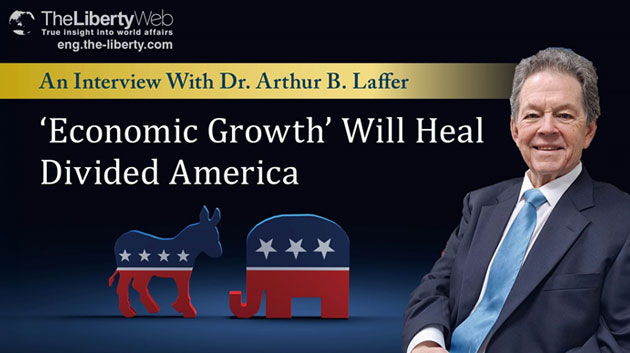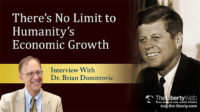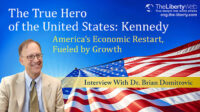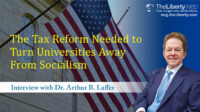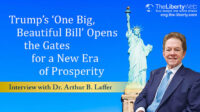‘Economic Growth’ Will Heal Divided America
An Interview With Dr. Arthur B. Laffer
Interviewer: Hanako Cho
Hanako Cho: Some people are starting to predict that depending on the outcome of the U.S. presidential election, America will enter a civil war and that people will relocate from blue states to red states. What’s your take on these commentaries?
Dr. Arthur B. Laffer: I don’t think there will actually be shooting in the streets, but what you are seeing right now with a lot of other things like poverty, racial discrimination and gender discrimination are, to a large extent, consequences of the view you have about economics.
What you’re having in the U.S. today and in the rest of the world are two very different visions of what economics is, what economics should be and what really produces results. [The two views] have both been very dominant from time to time in the field of politics.
The Battleground in Economics of Work, Savings and Tax Revenues: Keynesian Model Ignores Incentives
Dr. Laffer: Let me introduce you to the two views of the world held between the Keynesian redistributionists and the supply-side growthists under three scenarios. I’m going to characterize them extremely. Forgive me for being simplistic in it.
The first relates to work.
The redistributionists believe that people work because there are jobs. So what the government needs to do is create jobs and then people will automatically work. The other view of the world under growthists is that people work to get paid after-tax income. The only way government will increase the employment rate is to increase the after-tax pay in order to increase the incentives for people to go to work. Really, the reason people work is because they make a sufficient amount more working after tax than they do pretax not working and the welfare payments and all that. The problem with social welfare largely relates to this.
These are two very, very different models of the world.
When I start [talking] on economics, I always say that economics is all about incentives.
There are two types of incentives, positive incentives and negative incentives. Negative incentives tell you what not to do and positive incentives tell you what to do. When you look at work from the standpoint of my view of incentives, taxes make work less attractive and welfare payments for being unemployed makes non-work more attractive.
You hear the politicians, right and left, saying, “Oh, I created 20 million jobs.” But that reflects a view of the world. That’s the number one difference.
The second difference is on savings.
The redistributionists think that people save because their incomes are high. Rich people save more than poor people, and therefore rich people make what they spend, and poor people spend what they make. Therefore, they believe that savings is very much a function of the level of income. It’s a very simple Keynesian model here that savings is a function of income and the higher income, the higher the savings rate. The savings rate combined with the consumption rate creates the prosperity there on the Keynesian side.
Meanwhile, those people who are incentive-based supply-side people say that people save to augment their wealth, not to reduce their wealth. Therefore, they believe it’s the after-tax rate of return on savings that determines how much people save, not so much the level of their income.
So on the topic of whether to work or not, redistributionists say it’s jobs (i.e. people will automatically work if government creates jobs) while the growthists say it’s after-tax pay. On the topic of saving, redistributionists say savings is a function of income while growthists say savings are determined on the after-tax return on capital.
The third area is implicit in everything the redistributionists say. There are a lot of people who believe this and not only believe it, but think it’s really right. It has a crude logic to it. They don’t talk about it in depth for good reason.
They believe there is a direct line between tax rates and tax revenues.
These people believe that if you raise tax rates by 10%, you will increase tax revenues by 10%. If you lower tax rates by 10%, you will drop tax revenues by 10%. Their view of the world is that government revenues are directly related to tax rates and that there’s a one-to-one correspondence with tax rates and tax revenues.
We [supply-side growthists] view the world very differently. We view that there are two effects that tax rates have on total revenues. One effect they’re completely correct on is if you raise tax rates, you do collect more revenue per dollar of tax base. If you lower tax rates, you do collect less revenue per dollar of tax base.
But there’s a second effect which is when you raise tax rates, you reduce the incentives for doing the activity and you will shrink the tax base. You will shrink it in terms of production, employment and output, but you’ll also shrink it in terms of tax shelters, tax avoidance, tax shifting, all of this other stuff.
Now, these two effects on tax rates always work in the opposite direction. When you raise tax rates, you do collect more revenue per dollar of tax base, but you also shrink the tax base.
These two effects always work in the opposite direction because tax revenues are really “tax rates times the tax base.” Sometimes the effect of tax rates on the tax base are greater than they are on the tax rate, and sometimes the tax rate effect on the tax base are smaller than the effect of tax rates. Sometimes when you raise tax rates, you do collect more revenue.
But there are also times, Hanako, when you raise tax rates, you impact the tax base so much that you collect less revenues. Sometimes when you lower tax rates, you expand the tax base so much that it more than offsets the effect on tax rates on the tax base and you will actually increase revenues.
Now, to those of us who are supply-siders on this issue, it is an empirical issue.
‘This is About Facts, Not Your Feelings’
Dr. Laffer: I can fully understand someone who says, “I believe that if we raise tax rates, we’ll collect more revenues.” Yeah, that’s logical. The issue is what actually happens. Now, this is not about how you feel. This is about facts, not your feelings. And we have a lot of data on what has happened with tax rates and tax revenues.
Now, the two areas I’ve focused on most thoroughly in my life are, one, on the macroeconomic effects of tax rates, especially on the rich in the United States. That’s the book, Taxes Have Consequences. That is a thorough review of the income tax of the United States and its effect on tax revenues, productivity, output, redistribution, all of that. That’s what the book has focused on in large part.
There’s another book I wrote back in 2014, the New York Times Bestseller, which is The Wealth of States. For this book, I looked at the 50 states in the United States and said, “What happens to states that have lowered their tax rates compared to those states that have raised their tax rates?” I’ve looked at the income tax, sales tax, corporate tax, property tax. I’ve looked at all sorts of different events there.
This is the battleground between those who believe in an income-determined model, jobs, savings, and tax revenues raised by tax rates, and those of us who are on the other side of the ledger who believe that after-tax income is an after-tax return on savings, and it’s really up in the air what happens to revenues when you raise or lower tax rates. This is the battleground in economics.
‘Enterprise Zone Proposal’ Contributes to Reducing Poverty and Racial Discrimination
Dr. Laffer: A lot of problems like poverty, racial discrimination and gender discrimination are, to a large extent, consequences of the view you have about economics. If you believe in economic growth, you believe that growth will take care of income inequality and gender equality. It’s growth that will remove poverty and all of those things, especially in the inner cities.
I wrote on enterprise zones in 1974 as to answer the question of, “How do you bring incentives back into the inner cities?”
One of my suggestions was to exempt income taxes up to $50,000. This is because a single mother in Philadelphia who makes $58,000 a year will be taxed $27,000, so she wouldn’t work to make above $29,000 in the first place. If she were to earn above $29,000 of income, her effective tax rate on total income is very close to 100%. In some areas, they’re well over 100% because they lose more in welfare than they gain in earnings. This is called the “poverty trap.”
You can add the earned income and the welfare benefits to get the total spending power, but in this case, they now lose some of the welfare benefits they otherwise would have received. In my eyes, a family of four going from zero income to a higher income does not benefit much from the increase in earned income.
This poverty trap in the inner cities can happen to a black family, a white family in Appalachia or to any ethnic group.
‘War on Poverty’ Creates More Poverty
Dr. Laffer: This has been in the United States predominantly since the 1960s since [President] Lyndon Johnson implemented the “War on Poverty,” a government spending program that paid people who were poor. When you pay people who are poor, you’re going to create more people who are poor. But this is the battleground.
These areas bleed into all sorts of social issues. The question is, “What will be the outcome?” “What will be the outcome of this battle here in the United States?”
I’m going to tell you my vision of this world, and it’s just a vision. I’m not Methuselah. I haven’t lived through 55 revolutions. But my vision of the world is that one of the two sides has to win and has to win convincingly so the other side is defeated.
Can America Come Back From Senescence?
Dr. Laffer: You had World War II and then we had Truman the socialist after that. Then Eisenhower was a redistributionist as well. Then, we had springtime with John F. Kennedy but that was a very short period followed up Johnson, Nixon, Ford and Carter, who were all bipartisan redistributionists. Then we had springtime with Ronald Reagan coming through. With Reagan, the pro-growth agenda people won. It became a growth economy. The Bill Clinton era was also a growth economy and the world was growth for 25, 30 years.
Now you’ve had a very strong period of anti-growth for the last 25 years. It’s not just the U.S. It’s in the world. It’s in Japan. It’s in Russia. It’s in China. It’s in Europe. It’s in Chile. It’s in Argentina. Japan has been disappearing form the face of the earth because of this redistributionist model.
I call this period of anti-growth in the U.S. the “senescence.”
I’m very concerned about it. But one thing I’m more concerned about than the outcome is I don’t fully understand why this issue isn’t solved academically, scholarly and factually. It’s not.
The factual results are, if you look at the income tax codes, whenever we raise the highest marginal income tax rate on the rich, the economy has underperformed, tax revenues from the rich have gone down and the poor have been hurt. Those are the facts. Every time we’ve lowered tax rates on the rich, the economy has outperformed, tax revenues from the rich have gone up and the poor have done relatively well. Those are the facts. But the facts are not enough to convince people of the truth.
But Trump’s win in 2016 broke through the 25-year period of senescence.
Right now, the battle is in high gear here in the United States on whether or not Trump will win and bring us back into a pro-growth era again like it was under Kennedy and Reagan.
I don’t know which one is going to win but this is the battleground that you’re watching.
Now, will it turn into an actual civil war? Will it actually be shooting on the streets? I don’t think so. But all of these other issues on sexual orientation, gender, race, all these things take hold during periods of poverty and slow growth, during periods of underperformance. And this agenda comes through as not just to help the poor, but also to hurt the rich. The dislike of success is also part of their agenda.
Which Policies Will Make a State Prosperous?
Cho: Several years ago, Professors Paul Pierson and Jacob Hacker published an article in the New York Times titled, “The Path to Prosperity Is Blue.” In the article, these two argue that blue states are ahead in all key areas including median household income, life expectancy, birth rate, the level of high taxation on the top 1% and the percentage of those who obtained a bachelor’s degree. They didn’t take into account the outflow of population and capital, and I also thought that whether or not the top 1% got taxed was irrelevant to a state’s growth factors. Do you believe these indicators prove the superiority of blue states?
Dr. Laffer: The question is, what can you tease out of these data to give you a policy prescription for moving forward? In other words, if I were to use the blue state model, would that improve the performance of red states or would it worsen the performance of red states? If I were to use the red state model, would that improve the performance of blue states? Or would that hurt the performance of blue states? The facts they mentioned are all side issues.
I have directed my life focused on what policies would, if adopted, improve the circumstances.
But let me start off by saying that they’re not misleading. They look at blue states and say, “Is the education level higher in blue states than it is in red states?” And yes, it is. I can go through life expectancy too. In Mississippi, in Louisiana and in Alabama, life expectancy is low, education is low and incomes are low. They call these states red states and blue states. They look at whether they have Democratic governors and legislatures or Republicans. I don’t think of it in those terms. I define it much more precisely. I think of it in terms of policies.
The Experiment Between Red States and Blue States
Dr. Laffer: Now, the thing that’s important here, Hanako, is I don’t have the power as a little professor sitting in America. I don’t have the power to run experiments. I can’t go in there and tell the government, “Well, New York, I want you to get rid of your income tax. Let’s see what happens.”
We have to take the evidence that comes to us from the political process and try to tease the results. Let me give you an example of that process with regard to smoking.
Now, when you look at the incidence of cancer among people who do smoke versus people who don’t smoke, number one, there has to be a correlation between the activity and the outcomes. In other words, do smokers have more cancer than non-smokers? The second thing is that you have to isolate that correlation. You have to make sure that that correlation is a pure correlation and not just a correlation with lots of other things. You have to weed out all of the other factors because “A can cause C” or “A can cause B” or “B can cause C.” You’ll find a correlation between A and C but it’s not because A causes C. It’s because B causes C, and A and B are correlated. So once you have a correlation, you also have to have an isolation.
Lastly, you have to have an “insertion.” If we could get half the non-smokers to start smoking, what would happen? Now, the other one is “removal.” If we could take half the smokers and get them to stop smoking, would there be a change in outcomes? That’s what we want to do. With cigarettes and a lot of other diseases and all this research we do in medicine, we can do that. We really can do the double-blind tests. And with economics, we can’t.
Income Taxes, A Crucial Metric
Dr. Laffer: What has happened to states that have introduced an income tax? Now, that’s a factual question.
I wrote on this in my book, The Wealth of States, but since 1960, there have been 11 states that have introduced an income tax. Number one, if you look at those states that have introduced the income tax starting with West Virginia in 1961, ending with Connecticut. These 11 states include West Virginia, Rhode Island, Maine, Connecticut, New Jersey, Pennsylvania, Ohio, Illinois, Michigan, Indiana and Nebraska. In 1991, I looked at those 11 states and I looked at them relative to the rest of the nation, the 39 states that did not introduce or got rid of an income tax.
I looked at those 11 states in the five years preceding the introduction of the income tax and the most recent five-year period. I looked at them in terms of population, income, gross state product and tax revenues.
From the five years preceding the introduction of an income tax to the present, each one of these states, without exception, declined relative to the rest of the nation after they introduced the income tax. Some of these states were very, very prosperous states. Ohio, Pennsylvania, Connecticut, Michigan and New Jersey were very prosperous states. They didn’t just decline by a little bit, Hanako. They declined by a lot. You can see the numbers in the book, but I mean, Michigan’s gross state product went from 5.2% of the U.S. economy to a 2.7%. They declined by 50% relative to the rest of the nation.
West Virginia [declined] by much more. Now, West Virginia was poor to begin with and now it’s much poorer.
If you look at New Jersey, in 1965, New Jersey had neither an income tax nor a sales tax and it was one of the fastest growing states in the nation. People from everywhere were moving into New Jersey. They introduced the taxes and now, New Jersey is one of the slowest growing or states. People are leaving like rats out of a sinking ship.
You can see Connecticut was one of the fastest growing states and now one of the slowest growing states.
Again, it’s not cause-effect nor is it perfectly scientific. There’s no way I could do a scientific experiment is look at those states without the income tax and compare their performance with those states with an income tax.
I’m using a moving average. If you look at it for the last 50 years using a 10-year moving average, those states without an income tax have way outperformed those states with the highest income taxes – year in, year out. There are years when they don’t, but that’s why you use a moving average. For example, you get Hurricane Katrina. So I use a 10-year moving average and the differences are substantial each and every year.
I did not run a scientific experiment but I conclude from this that the probabilities are very, very high that it was the introduction of the income tax and associated policies that led to the decline in the economic performance of these states.
The Decline of Public Services
Dr. Laffer: I then looked at those 11 states and looked at the provision of public services. I looked at their education standards, highway, police protection, fire protection and all of these other things. In other words, they wanted to use the tax money to fund public services so I looked at the public services.
What I found was that the provision of public services did not improve in those 11 states. Their economy worsened substantially. The education standards judged by the Department of Education test scores and National Association of Educational Procurement (NAEP) scores did not improve relative to the rest of the nation. All the other public services in general did not improve. Their tax revenues did not rise relative to the rest of the nation, which I take as being a very serious, significant indicator of the results from the world.
Now, everyone points to California as being the exception. They’ve got high taxes. Their housing prices are high. But California has performed extraordinarily well given its income taxes and corporate taxes. They have one magical bullet that has kept California from becoming West Virginia. That’s Proposition 13.
Dr. Laffer’s Contribution to Proposition 13: the Prosperity DNA Engraved Within California’s State Constitution
Dr. Laffer: California’s property taxes are a huge percentage of total state and local taxation.
In 1978, California adopted single strict limits on property taxes, perhaps the most stringent limits in the United States. Property taxes were limited to being no more than 1% of market value. There was now a constitutional limitation on property taxes, okay?
When they were put in, the effective tax rate of a property tax was about 2.58% of market value. So one day, they reduced the property tax rate by 60%. If you look at what happened to California following that, it is amazing.
California’s growth rate went way, way up. It became one of the fastest growing states in the nation. The unemployment rate in California went from 2.5% above the national average to below the national average.
Home prices, which had been about equal to the rest of the nation, more than doubled relative to the rest of the nation. California’s population grew by the size of Massachusetts over the next decade. It grew by San Francisco. Its real income grew. California was the Mecca of economic prosperity.
I’m going to tell you it’s because of Proposition 13. Housing is about 50% of the capital stock of America. The capital gains tax rate was reduced by dramatic amounts to where now, California property tax bills not only cannot exceed 1% of market value ever but they also cannot grow by more than 2% per annum for a single owner.
Today, California’s property tax rates are one of the lowest in the nation. Property tax rates are really low but property values are so high that California collects a lot of money in property tax revenues.
This is the exact essence of the growth model. Property taxes, I would argue, have led to the huge performance of California even despite problems they’ve done with income taxes, sales taxes, corporate taxes and all of those have horrible regulations.
All of that stuff have been horrible, but people can choose to avoid those taxes. They cannot choose to avoid property taxes. You can’t move your property after all.
‘Tax Advantages on Capital Gains’ Also Leads to California’s Growth
Dr. Laffer: Now, let me go through a little bit else that’s important in California. Not only are property tax rates low, but there are tax advantages related to the increases in property values, what we call “unrealized capital gains.” These are not taxed in the United States. They are not taxed at the federal level, and they’re not taxed at the state and local level either. All the increases in unrealized capital gains are not taxed.
If you were to sell your asset gains, there are very distinct advantages to capital gains on homes. For example, the first $500,000 capital gain on your homes are not taxable for a couple. $250,000 are not taxable for an individual.
That’s a very clear preference for capital gains on homes that make that a favored investment.
In addition to that, if you keep your capital gains until death, when you die, your capital gains go into the estate at their value. There’s what’s called a “step-up basis” that you never have to pay capital gains taxes if your asset is in your estate. We have all of these tax advantages to capital gains.
That has endured very much to the outperformance of California in the United States. I’m not going to go into California anymore, but you can see why I think California has been a perfect example of what good tax policy can do to keep prosperity even in a blue state.
Would they do a lot better if they did better in income taxes? Yes. Would they do a lot better if they did better in corporate taxes? Yes. Would they do a lot better if they did better on sales taxes? Yes. Would they do a lot better if they did more favorable regulations? Yes. But they have a magical bullet that has kept California from becoming West Virginia.
Why Using ‘Income Per Capita’ is Wrong
Dr. Laffer: Now, there is a metric that the two professors use in their NY Times article that I want to talk through with you.
These people often use “income per capita” as an argument. “When you put in a tax, yeah the state may shrink but income per capita goes up.”
It is an incorrect measure using income per capita for two reasons. One, income itself is incentivized by tax policies. The number of people in a state is incentivized by tax policies. If you raise taxes, you will tend to reduce income growth and reduce population growth as well.
In Nevada, which is probably the most tax-favorable state in the nation, you have huge growth in income and huge growth in population, but their income per capita has declined relative to the rest of the nation. They’ve attracted people faster than they have [increased] income. Because a lot of the low-income people have come into Nevada to make money, it’s lowered the average income per capita.
In West Virginia, which is probably the worst state in the nation for economic policies, income is declining rapidly and population is declining rapidly, but people are leaving faster than income is declining. Therefore, income per capita in West Virginia is growing.
You can never use the “income per capita” ratio as a measure. These people use those ratios. I have to tell you that if they were familiar with the literature, they should have known better than to do that.
Tons of Evidence Support the Growth Model
Dr. Laffer:In my book, An Inquiry into the Nature and Causes of the Wealth of States, which I did with Rex Sinquefield, Travis Brown and Steve Moore, I looked very closely at comparisons of Texas vs. California, Tennessee vs. Kentucky, New Hampshire vs. Vermont, Florida vs. New York. Based on the preponderance of evidence, I have come to the conclusion that supply-side economics and tax policies make a huge difference on the performance of states.
Supply-side policies make a huge difference on the performance of the U.S. over time. If you look at time series on the U.S., if you look at the cross-section time series on states and if you look at detailed analyses of the individual periods, I am inextricably brought to the conclusion that taxes do have consequences.
I am brought to the conclusion that in the debate between the growthist and the redistributionist model, the evidence found in states and in the United States have predominantly supported the growthist model over the redistributionist model. I would love to have a debate with them and to do a full debate on states with them.
I could give you tons and tons of examples that tend to corroborate the growth model, the growth agenda model, and not the Keynesian income generation model of, “We need jobs. We need welfare. We need to pay people. Build all this.”
Building a Moral, Just and Equitable Society Without Sacrificing Economic Growth
Dr. Laffer: I conclude from all of this that you cannot tax an economy into prosperity, and a poor person cannot spend himself into wealth.
The government is not the source of economic growth. People are. Government can stop growth but it can’t make growth happen. The best government for growth is that set of government policies that does not discriminate against success.
If you tax people who work and you pay people who don’t work, you’re going to get a lot less people working than if you don’t tax people who work and don’t pay people who don’t work.
All of my policies over my whole career have been based upon how can we have a moral, just and equitable society without sacrificing economic growth.
That’s why a low-rate, broad-based flat tax, spending restraint, sound money, minimal regulations, free trade, all of these policies have been my attempt and my whole life’s work to develop a supply-side agenda, the pillars of prosperity that would allow a country to be just, equitable, fair and at the same time, create prosperity for one and all.

